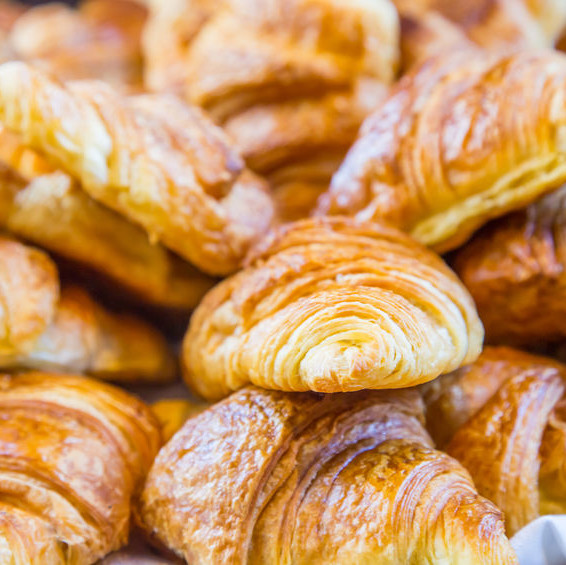
Glucose
Also known as dextrose or corn sugar
What is Glucose?
Glucose and dextrose are the same chemical, alpha-D-glucopyranose, which is a simple sugar. This sugar has a clean pleasant sweet taste, but is not quite as sweet as the table sugar sucrose. It is important in baking for sweetening as well as for sensory attributes, such as color and texture.
- Glucose is a syrup, most often sourced from hydrolyzed corn in the United States and is often called corn syrup.
- Dextrose, on the other hand, is a powder, purer and sweeter.
- Glucose and dextrose are available in different forms which affords flexibility for the baker.
Types
Codex specifications describe the different types of glucose and dextrose available.1 The FDA uses Codex specifications for their requirements for standardized sweeteners and table syrups or syrups (21 C.F.R. § 168 2018):
- Glucose syrup: A purified concentrated aqueous solution of nutritive saccharides obtained from starch and/or inulin. It can be named for the starch it’s derived from, so instead of being listed as glucose syrup it can be called “corn syrup”, “wheat syrup” or “sorghum grain syrup” on the ingredient label. Glucose syrup has a dextrose equivalent content of not less than 20.0% m/m (expressed as D-glucose on a dry basis), and a total solids content of not less than 70.0% m/m.
- Dried Glucose syrup: Glucose syrup from which the water has been partially removed to give a total solids content of not less than 93.0% m/m. If derived from a specific starch, such as corn, it can be named “corn syrup solids” or “dried corn syrup.”
- Dextrose monohydrate: Purified and crystallized D-glucose containing one molecule of water of crystallisation, with a D-glucose content of not less than 99.5% m/m on a dry basis and a total solids content of not less than 90.0% m/m. It can be named after the grain it’s derived from, such as “corn sugar monohydrate” or just “corn sugar.”
- Dextrose anhydrous: Purified and crystallized D-glucose without water of crystallization, with a D-glucose content of not less than 99.5% m/m on a dry basis and a total solids content of not less than 98.0% m/m. It can be named after the grain it’s derived from, such as “corn sugar anhydrous.”
- Powdered Dextrose (icing or doughnut sugar): Finely pulverized dextrose anhydrous or dextrose monohydrate or mixtures thereof, with or without the addition of an anti-caking agent.
Function
In addition to sweetening, some of the key functions of dextrose for bakers are to:
- Affect dough viscosity
- Depress freezing points of products
- Control crystallization in icings and glazes
- Promote fermentation
- Affect texture
- Promote tenderness
- Act as a reducing sugar for browning and flavor development via the Maillard reaction
Nutrition
Glucose is a carbohydrate source of energy, supplying 4 calories per gram. It is a simple sugar (monosaccharide), which is absorbed directly by the bloodstream.
Added sugar, such as dextrose and glucose, will be required to be identified on the nutrition facts label as added sugar when the new Nutrition Facts Label goes in effect in 2020.2
Commercial Production
Glucose is produced by dissolving starch in water and hydrolyzing with acids, enzymes or a combination of acid and enzymes. The source of starch can be from foods like corn, wheat, tapioca grain and sorghum grain. Dried glucose syrup is vacuum or spray dried and is a granular, semi-crystalline powder.
Manufacturers combine enzyme technology and acid hydrolysis to produce a wide variety of Dextrose Equivalent (DE) syrups. The lower DE corn syrups (36-62 DE) are less sweet and starch like, while higher DE syrups (62-95 DE) are sweeter and thinner. DE is how degree of hydrolysis of starch is measured. Pure dextrose has a DE of 100, anything lower than DE 20 is a starch.3
Dextrose monohydrate has a higher DE than the syrups and is produced by complete depolymerization of the starting starch material. A controlled crystallization process followed by a drying process, produces the final dextrose monohydrate powder. Dextrose anhydrous is redissolved dextrose monohydrate that is further refined, crystalized and dried to increase solids.
Application
Dextrose or corn syrup is not a direct substitute for sugar and work best in baked goods when combined with other sugars. In comparison to sugar, they promote browning and are not as sweet.
Bakers use dextrose or glucose syrup in biscuits, breads, rolls, cakes, cookies, crackers, doughnuts and frostings.
FDA Regulations
Dextrose and corn syrup are Generally Recognized as Safe (GRAS) by the FDA.3
References
- FAO, CODEX STANDARD FOR SUGARS CODEX STAN 212-1999, Accessed 4 April 2019.
- FDA. “Changes to the Nutrition Facts Label”. 2/08/2019. www.fda.gov/Food/GuidanceRegulation/GuidanceDocumentsRegulatoryInformation/LabelingNutrition/ucm385663.htm. Accessed 15 Feb. 2019.
- Corn Refiners Association. “Nutritive Sweeteners from Corn, 8th Edition”. 2006. https://corn.org/wp-content/uploads/2009/12/NSFC2006.pdf. Accessed 5 April 2019.

